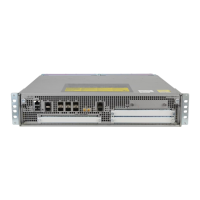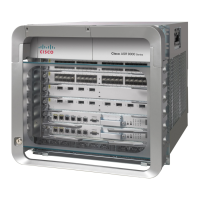Using Cisco IOS XE Software
Using the no and default Forms of Commands
11
Cisco ASR 1000 Series Aggregation Services Routers Software Configuration Guide
Using the no and default Forms of Commands
Almost every configuration command has a no form. In general, use the no form to disable a function.
Use the command without the no keyword to re-enable a disabled function or to enable a function that
is disabled by default. For example, IP routing is enabled by default. To disable IP routing, use the no ip
routing command; to re-enable IP routing, use the ip routing command. The Cisco IOS software
command reference publications provide the complete syntax for the configuration commands and
describe what the no form of a command does.
Many CLI commands also have a def
ault form. By issuing the command default command-name, you
can configure the command to its default setting. The Cisco IOS software command reference
publications describe the function of the default form of the command when the default form performs
a different function than the plain and no forms of the command. To see what default commands are
available on your system, enter default ? in the appropriate command mode.
Router(config-if)# ip address ?
A.B.C.D IP address
negotiated IP Address negotiated over PPP
Router(config-if)# ip address
Enter the command that you want to configure for
the interface. This example uses the ip address
command.
Enter ? t
o display what you must enter next on the
command line. In this example, you must enter an IP
address or the negotiated keyword.
A carriage return (<cr>) is not displayed; therefore,
you
must enter additional keywords or arguments to
complete the command.
Router(config-if)# ip address 172.16.0.1 ?
A.B.C.D IP subnet mask
Router(config-if)# ip address 172.16.0.1
Enter the keyword or argument that you want to use.
This example uses the 172.16.0.1 IP address.
Enter ? t
o display what you must enter next on the
command line. In this example, you must enter an IP
subnet mask.
A <cr> is not displayed; therefore, you must enter
ad
ditional keywords or arguments to complete the
command.
Router(config-if)# ip address 172.16.0.1 255.255.255.0 ?
secondary Make this IP address a secondary
address
<cr>
Router(config-if)# ip address 172.16.0.1
255.255.255.0
Enter the IP subnet mask. This example uses the
255.255.255.0 IP subnet mask.
Enter ? t
o display what you must enter next on the
command line. In this example, you can enter the
secondary keyword, or you can press Enter.
A <cr> is displayed; you can press E
nter to
complete the command, or you can enter another
keyword.
Router(config-if)# ip address 172.16.0.1 255.255.255.0
Router(config-if)#
In this example, Enter is pressed to complete the
command.
Table 9 Finding Command Options (continued)
Command Comment

